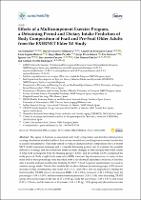Por favor, use este identificador para citar o enlazar este ítem:
https://repositorio.usj.es/handle/123456789/461
| Título : | Effects of a multicomponent exercise program, a detraining period and dietary intake prediction of body composition of frail and pre-frail older adults from the exernet elder 3.0 study |
| Autor: | Moradell, Ana


Navarrete-Villanueva, David 
Fernández-García, Ángel Iván 
Sagarra-Romero, Lucía 

Marín-Puyalto, Jorge 


Pérez-Gómez, Jorge 


Gesteiro, Eva 


Ara, Ignacio 
Casajus, José Antonio 


Gómez-Cabello, Alba 

Vicente-Rodríguez, Germán 


|
| Palabras clave : | Frailty; Adiposity; Exercise; Obesity; Sarcopenia; Energy intake |
| Fecha de publicación: | 26-nov-2020 |
| Editorial : | MDPI |
| Citación : | Moradell, A., Navarrete-Villanueva, D., Fernández-García, Á., Sagarra-Romero, L., Marín-Puyalto, J., Pérez-Gómez, J., Gesteiro, E., Ara, I., Casajus, J., Gómez-Cabello, A., Vicente-Rodríguez, G., 2020. Effects of a Multicomponent Exercise Program, a Detraining Period and Dietary Intake Prediction of Body Composition of Frail and Pre-Frail Older Adults from the EXERNET Elder 3.0 Study. Sustainability 12, 9894.. doi:10.3390/su12239894 |
| Resumen : | The aging of humans is associated with body composition and function deteriorationcreating a burden on an individual level, but also on a societal one, resulting in an economic burden thatis socially unsustainable. This study aimed to evaluate changes in body composition after a 6-monthMCT (multicomponent training) and a 4-month detraining period, and to examine the possibleinfluence of energy and macronutrient intake in these changes in frail and pre-frail older adults.A total of 43 participants from the training group (TRAIN) and 28 controls (CON) completed thestudy protocol. Body weight, body mass index (BMI), waist and hip circumferences, fat mass, fat freemass and fat mass percentage were recorded, with a bio-electrical impedance analyzer, at baseline,after6 monthsand four months after finishing the MCT. A food frequency questionnaire was used toestimate energy intake. Mixed effect models did not show differences between groups. CON showedincreases in hip circumference and waist (3.20±1.41 and3.06±1.66 cm,respectively) during thefirst 6 months. TRAIN showed decreases in BMI (−0.29±0.14), fat mass (−0.86±0.38 kg), body fatpercentage (−0.98±0.36%) and increases in waist circumference (3.20±1.41).After detraining, TRAINgroup showed increases in fat mas (1.07±0.30 kg), body fat percentage (1.43±0.31%) and waist(3.92±1.38 cm),and decreases in fat free mass (−0.90±0.30 kg). CON group only showed an increase in body fat (1.32±0.47%). Energy intake was negatively associated with hip circumference in thefirst six months and fat mass during detraining in CON. Energy intake showed positive associationswith fat mass in TRAIN during detraining. Only carbohydrates were negatively related to detrainingchanges in fat free mass and BMI in CON. In conclusion, the MCT reduces adiposity of frail andpre-frail older people, leading to a maintenance of fat free mass. In addition, these interventionsshould not be stopped in this population in order to improve health sustainability. |
| URI : | https://repositorio.usj.es/handle/123456789/461 |
| ISSN : | 2071-1050 |
| Aparece en las colecciones: | Artículos de revistas |
Ficheros en este ítem:
| Fichero | Descripción | Tamaño | Formato | |
|---|---|---|---|---|
| Effects of a multicomponent exercise program, a detraining period and dietary intake prediction of body composition of frail and pre-frail older adults from the exernet elder 3.0 study.pdf | 581,33 kB | Adobe PDF |  Visualizar/Abrir |
Este ítem está sujeto a una licencia Creative Commons Licencia Creative Commons

